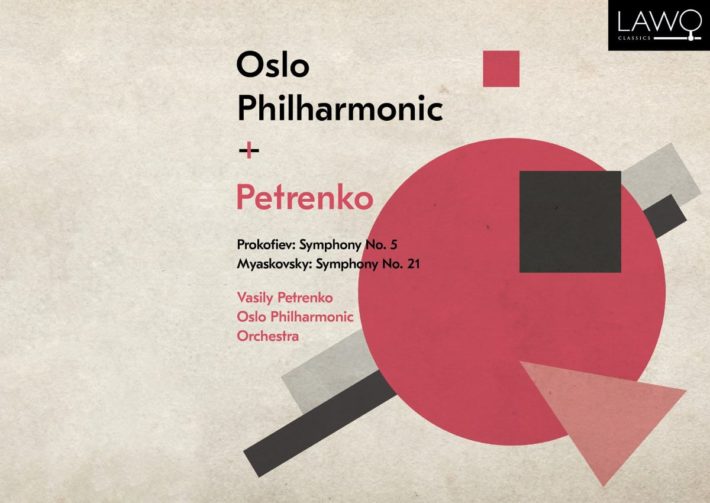Vasily Petrenko continues his exploration of the music of his homeland. His Shostakovich symphony cycle with the Royal Liverpool Philharmonic Orchestra (Naxos) was a significant achievement, raising the international stature of both orchestra and conductor. Together they also released well-regarded cycles of Tchaikovsky (Onyx) and Rachmaninov symphonies (Warner Classics), as well as Stravinsky’s three Russian ballets (Onyx). Petrenko has also focused on Russian music in Oslo, with recordings of Scriabin symphonies and Prokofiev’s Romeo and Juliet. Now, Petrenko and his Oslo orchestra offer Prokofiev’s Fifth Symphony, coupled with a work (and composer) certainly deserving of greater recognition, Myaskovsky’s Symphony No. 21.
The opening minutes of the Prokofiev make plain the excellence of this orchestra, with playing of admirable precision and refinement. Strings embrace a husky, dark richness, and the winds have considerable power. At louder dynamic levels the orchestra creates a weighty sound – in short, they have a color palette perfectly suited for this repertoire. Petrenko and the recording engineers allow much inner detail to emerge and I was consistently impressed by the orchestra’s soft playing. Great care is taken to honor every piano and pianissimo marking, without ever allowing tone to sound under nourished.
Unfortunately, Petrenko’s tempo choice proves problematic: his first movement (14’14”) is considerably slower than both Jarvi in Scotland (12’22”/Chandos) and Karajan in Berlin (13’03”/DG). It is not that the tempi are inherently wrong (Litton is equally slow in his recording with the Bergen Philharmonic), but here the tempi often stall the sense of forward momentum inherent in Prokofiev’s writing. Both Jarvi and Petrenko establish a beguiling sense of mystery at the beginning of the movement, but Jarvi’s faster pace allows the music to develop a jauntiness that propels the music forward, whereas Petrenko wallows in the darkly beautiful colors his players conjure. Or sample the introduction of the secondary melodic material, first introduced at 5’23”: both Jarvi (4’44”) and Karajan (5’07”) press forward, creating a more lighthearted atmosphere, whereas Petrenko’s seems intent on maintaining a noble but melancholic mood.
The Coda (11’42”), with its orchestrated climax, is also unconvincing. Brass chords lead into a richly harmonized string rendition of the first theme, timpani propelling the music on. This theme is then repeated by the full orchestra as snare drum, tam-tam and cymbal crashes build tension until a final eruption. But the Oslo brass and percussion are reigned in, robbing the climax of the snarling intensity heard in Scotland and Berlin.
Related Classical Music Reviews
- Review: Rimsky-Korsakov – Orchestral Works – Oslo Philharmonic, Vasily Petrenko
- Review: Shostakovich – Symphony No. 13 (“Babi Yar”) – Russian National Orchestra – Karabits
- Review: “Silver Age” – Daniil Trifonov Plays Stravinsky, Prokofiev, Scriabin
The second movement is more consistently impressive, strings and woodwinds articulating their motorized writing with unremitting intensity. Again, Petrenko’s drastic tempo change for the transition between the end of the trio and the return of the opening music is unconvincing. And while the Adagio offers playing of great sensitivity and refined coloration, Petrenko’s slow tempo works against any sustained buildup of tension and energy. This is, in fact, the slowest performance of the third movement I know. Even Andrew Litton’s Bergen performance, one of the slowest on record (12’46”), plays this movement almost two minutes faster. And his Bergen player more fully convey the desperate urgency of this music, helped by the sonic excellence of the BIS recording.
Everything suddenly falls into place for the final movement. The orchestra plays as if possessed, reveling in the music’s playful jubilation. The final minute is especially thrilling as trumpets blast out the final statement of the theme with a gleeful brashness.
I don’t understand why Myaskovsky’s music is not more widely known. His 27 symphonies should appeal to anyone interested in Tchaikovsky, Shostakovich, Weinberg, and Prokofiev (with whom he was good friends). His music is openly emotional in a late-Romantic style, with sweeping melodies, lush harmonies, and dark-hued orchestral timbres. This is one of the more recorded symphonies; by my reckoning this is its fifth commercial recording.
In one movement, the opening solo for clarinet sets an elegiac tone that hangs over the entire work. The Allegro sections establish an optimism that feels somewhat forced, reminiscent of similar moments in Shostakovich’s symphonies. For this review, I revised a recording by Svetlanov of this symphony, with the Russian Federation Academic Symphony Orchestra. While the string playing is impressively rich, ensemble can be untidy, wind intonation can wander, and trumpets have an unattractive wobble. The Oslo players are in a completely different class, playing with great precision and tonal sophistication. Petrenko, who seems to have a better handle of the work’s sprawling structure, is also about three minutes faster, creating a greater sense of overall cohesion. How wonderful it would be if this marked the beginning of a new Myaskovsky cycle.
Recorded sound is very fine, though it does not match the excellence of the Litton/BIS or Gaffigan/Challenge Classics recordings. While the Prokofiev can be recommended with qualification, the Myaskovsky is a complete success.

Prokofiev – Symphony No. 5
Myaskovsky – Symphony No. 21
Oslo Philharmonic Orchestra
Vasily Petrenko – Conductor
Prokofiev Symphony No. 5 – Recommended Comparisons
Read more classical music reviews or visit The Classic Review Amazon store
Follow Us and Comment:
Get our periodic classical music newsletter with our recent reviews, news and beginners guides.
We respect your privacy.









